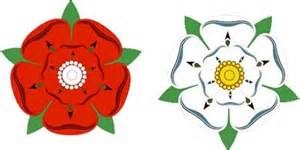
The War of the Roses was a series of battles between two competing houses for the crown of England. The House of Lancaster (represented by a red rose) and the House of York (represented by a white rose) fought until a third house, the House of Tudor, eventually took control.
The Split of the House of Plantagenet
England had been run by the House of Plantagenet since the 12th century. However in-fighting, exile and The Hundred Years War split the family.
The House of Lancaster and the House of York were offshoots of the Plantagenets, linked by sons of Edward III (who had 13 children).
When Henry IV (of the Lancasters) took the throne by force it ended the direct line of Plantagenets.
The House of Lancaster in Control
When Henry IV took control, the House of York did not resist. The court was firmly with the House of Lancaster.
After Henry IV died he was succeeded by Henry V, a popular king due to his victories against France. Again, the House of York did not raise concern.
However, when Henry VI came to power, problems emerged. Henry VI was seen as a weak leader, prone to madness, and his wife Margaret of Anjou was overly ambitious.
When Henry VI fell into insanity, Richard Neville, the Earl of Warwick nicknamed ‘The Kingmaker’ , put Richard, Duke of York, in charge. Henry VI, however, recovered, and began (with his wife) to seek a reassertion of power.
The War of the Roses Begins
The first major battle between the two houses occurred at St. Albans on May 22 1455. The House of York won. There followed a 4 year truce.
Fighting began again in 1459, and although the House of York won the first battle, they were pushed back in October. The Earl of Warwick rebuilt forces whilst in France, and in 1460 the House of York returned and won the Battle of Northampton.
The House of York agreed they would take the throne once Henry VI died. This meant Henry’s son, Prince Edward, would not be king. Edward and Margaret objected.
A Second Wave of Fighting
The House of Lancaster rebuilt its forces in the north of England. In December 1460 they surprised the House of York. Richard, The Duke of York was beheaded, along with his second son, Edmund at the Battle of Wakefield. The House of Lancaster marched towards London.
Richard’s eldest son, also named Edward, took charge of the House of York. He also took his army to London, arriving before Margaret. He was proclaimed King Edward IV and began to chase Margaret back north.
In March 1461 Edward IV beat the Lancastrian forces at the Battle of Towton. It was a crushing victory, and remains the bloodiest battle ever fought on British soil. 30000 people died (20000 from the House of Lancaster).
Edward vs. The Kingmaker
After the defeat at Towton, the Lancastrian forces returned to the north to regroup. There were efforts to revolt, but in 1464 Edward crushed the forces again, capturing Henry VI.
Edward, however, made enemies in his own house when he began to favour those connected to his wife, Elizabeth Woodville. One of those enemies was Richard Neville, Duke of Warwick, ‘The Kingmaker’ – the man who had helped his father become king.
At first Warwick tried to have Edward replaced by his younger brother, George, Duke of Clarence. When this failed, Warwick remarkably swapped sides. He tried to get Henry VI returned to the throne.
Edward and Warwick were now at war. Yet Edward would cement his power in crushing style: he won the Battle of Barnet in April 1471, where Warwick was killed. In May 1471 he won the Battle of Tewkesbury, executing Henry VI’s son Prince Edward in the process.
A few days later he had Henry VI executed in the Tower of London, finishing the House of Lancaster’s direct line to the throne.
The Final Winner: The House of Tudor

With the House of Lancaster seemingly beaten, a time of relative peace followed. Edward IV, however, died in 1483.
The heirs were still children and Edward’s brother, Richard of Gloucester, saw an opportunity. Although the eldest boy Edward was named king (Edward V) Richard claimed their father’s marriage had not been legitimate. He put the children in the Tower of London, and they were never seen again.
Meanwhile Henry Tudor, a distant cousin of the Lancaster family, took on the Lancaster’s claim to the throne. He used his family connection and the hatred of Richard to build an army.
Henry’s army fought Richard at the Battle of Bosworth in 1485. Henry won, making him King Henry VII. To cement the Tudor’s claim he married Edward IV’s daughter, Elizabeth of York.
With the two houses combined, the Tudors took control of England.

Cleaning Up the Dispute
The Tudors now ruled England. There were, however, some loose-ends to tie up.
A man claiming to be Edward, Earl of Warwick and the son of George (Edward IV’s brother) was found to be a pretender called Lambert Simnel. A man called Richard Simon wanted to be another kingmaker after seeing a likeness between Simnel and Edward IV’s children.
Another man named Perkin Warbeck claimed to be the son of Edward V (the boy king who disappeared in the Tower of London). He was imprisoned and executed.
